Top News

March 14, 2020 Ryukyu Shimpo
The Japanese government formed the “Okinawa Regional Safety Patrol”, also known as “ao-pato” (literally: blue patrol), in response to the 2016 incident in which a U.S. military-civilian (a Marine Corps veteran) killed an Okinawan woman.
The aim of the initiative was to prevent further military-related incidents.
However, the Cabinet stated on March 13, “Its objective is to prevent crimes in Okinawa and does not target specific entities.”
The Cabinet’s statement was released in response to questions raised by Diet member Mikio Shimoji.
Approximately 1.905 billion yen was poured into the Okinawa Regional Safety Patrol initiative between 2016 and 2018 to prevent further incidents involving military-civilians, but the government effectively denied the initiative’s original purpose.
According to the statement, the patrol unit received a total of 1,223 calls between fiscal year 2016 and 2018, of which 78.6% were drunk and disorderly cases.
Eight of the calls involved U.S. military and civilian personnel.
Suggestions were made to use the number of calls received by police for statistics, but the Cabinet responded, “It is inappropriate to look at [those] high figures to establish the validity of this initiative.”
(English translation by T&CT and Monica Shingaki)
Go To Japanese

March 21, 2020 Ryukyu Shimpo
Japan Transocean Air (JTA) announced their plan to suspend 60 flight routes from Naha, Fukuoka, Miyako, and Ishigaki from March 29 through April 5.
This decision was made due to reduced demand from passengers amidst the ongoing coronavirus pandemic.
The suspensions include 10 routes between Fukuoka and Naha, 26 routes between Naha and Miyako, and 24 routes between Naha and Ishigaki.
Passengers who have made reservations for a suspended flight will be allowed to substitute that flight for another one.
(English translation by T&CT and Sam Grieb)
Go To Japanese
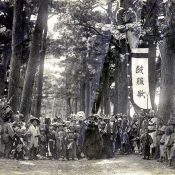
March 18, 2020 Ryukyu Shimpo
By Kazuki Furugen
Recently, 88 pre-war photographs such as the one above, which shows locals gathered on the day of a folk art festival taken in 1925 at the “Ginon Nanmachi,” a national natural monument consisting of a row of pine trees connecting Futuenma in Ginowan, were discovered.
According to the Ginowan museum, pictures of the Futenma pine forest have been previously found, but this is the first time in which the faces of the local can be clearly seen, as well as wearing the folk art attire.
Learning about the existence of pre-war folk art alone makes these pictures incredibly valuable.
The 88 newly discovered photographs span a timeframe of 29 years, from 1916 to right before the Battle of Okinawa in 1945, taken by Takamoto Matsunaga (1892-1965), an agricultural engineer from Kagoshima Prefecture who was staying in Okinawa.
He had left behind an album of pictures taken where he was working in Nago, Futenma, an Oroku (modern-day Naha).
The pictures were given to Naha historian Takao Nonomura from Matsunaga’s second daughter Taeko, who lives in Miyazaki Prefecture.
The photographs of the pine forest were confirmed by ex-Futenma ward chief Masamichi Miyagi, 86, who has lived in Futenma since before the war, and says that the photograph is likely taken at the pre-war Futenma pine forest.
Kenya Heshiki from the Ginowan History Museum indicates, “This is the first photograph from the pre-war era depicting folk art such as the milk mask.”
In pre-war Futenma, there was also a local event that took place once every four-to-five years called the “Futenma Maruashibi,” which took place in 1925.
There is also records of a group dance called “The young Kushi chieftain” performed at that time, and it is possible the people in costume in the photograph participated in the dance.
Heshiki said, “A photograph depicting things such as the milk mask, the flag, and the children’s clothing is valuable. You can feel the enthusiasm for preserving the local festival.”
Nonomura, the recipient of the photographs, commented, “I think this could be useful to the people of each community as a document of each regions local history,” stressing that the photographs should be put to good use in Nago, Futenma, and Oroku (Naha).
(English translation by T&CT and Sam Grieb)
Go To Japanese

March 18, 2020 Ryukyu Shimpo
On March 17 it came to light that townspeople had been successively lodging complaints concerning the national anthems of Japan and the United States being projected at 90 decibels or higher at around 8:00 a.m. from on the compound of MCAS Futenma in Ginowan City, Okinawa.
On the same day at a general inquiry session at the city council, the head of Ginowan City’s Military Base Policy Committee, Koji Suzuki, explained the matter.
Suzuki reported that on March 11 Mayor Masanori Matsukawa was on a phone call with the Commanding Officer for MCAS Futenma Col.
David Steele and spoke with him concerning the national anthem noise levels.
Mayor Matsukawa had taken notice of that the anthem noise levels had been rising and requested that the level be returned to that of one month prior.
Suzuki’s answers were in response to Hiroyuki Uezato (Kyosei no Kai) and Seiji Miyagi (Citizen’s Network).
(English translation by T&CT and Erin Jones)
Go To Japanese
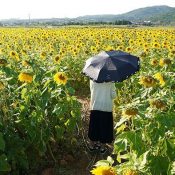
March 18, 2020 Ryukyu Shimpo
Kumejima – Enormous sunflower blossoms invite huge smiles. A field in Janadou, Kumejima is blanketed with yellow sunflowers.
Tourists stop to enjoy the contrast between the flowers and the blue sky.
The sunflower field is close to the Kumejima Eef Beach Hotel. Large sunflowers cover the approximately 50-meter field.
A young office worker visiting from Naha says, “I’ve never seen sunflowers blanketing a field like this.” She adds, “it’s beautiful!”
(English translation by T&CT and Ellen Huntley)
Go To Japanese
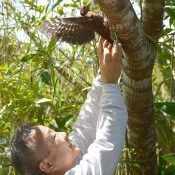
March 17, 2020 Ryukyu Shimpo
Kunigami, Okinawa—In the afternoon on March 16, a rescued Okinawa woodpecker was released back into the wild in Ada, Kunigami, where it was found injured. Okinawa woodpeckers are an endangered species and also designated a special national treasure. The bird was found entangled in a net meant to keep away wild boars, and its tail feather was injured. The woodpecker was taken in for rehabilitation for three-months following its rescue.
The Conservation & Animal Welfare Trust provided care for the woodpecker, and the vice president of the organization, Michio Kinjo, released the bird by perching it on to a tree branch. Onlookers included the farmer who rescued the Okinawa woodpecker and staff of the Yambaru Wildlife Conservation Center. The bird hopped up the tree branches and flew off into the forest.
The rescued Okinawa woodpecker was a young male bird about 10 months old. It was approximately 30 cm long and weighed 153 grams. It was found on December 25, 2019, entangled in a net and crying for help.
Kinjo commented, “The Okinawa woodpecker looks for food on the ground too. We shouldn’t leave unnecessary nets lying around, [they] need to be properly managed.”
(English translation by T&CT and Monica Shingaki)
Go to Japanese
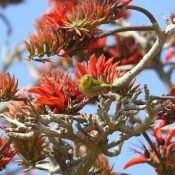
March 16, 2020 Ryukyu Shimpo
On March 15, high atmospheric pressure brought clear skies to the Okinawa region. Okinawa’s official flower, the deigo, of the legume family, was in full bloom at the Okinawa Comprehensive Athletic Park in Okinawa City, to the delight of visitors to the park.
The temperature in many areas fell below 20°C on the 15th, and the breeze made the air feel chilly, but the sunlight during the daytime was warm and comfortable. The deigo flowers were beautiful against the clear blue sky, and small white-eye birds flew around seeking the flowers’ sweet nectar.
According to the JMA Okinawa Regional Headquarters, the coming week will start off sunny with high atmospheric pressure, but cloudy days will come from mid-week onward as a result of a front and humid air.
(English translation by T&CT and Sandi Aritza)
Go to Japanese
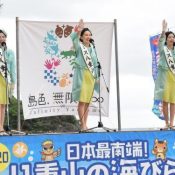
March 15, 2020 Ryukyu Shimpo
Ishigaki – “Japan’s Southernmost point! Yaeyama Beach Opening 2020” (hosted by the Yaeyama Visitor’s Bureau) was held March 14 at Sukuji Beach in Kabira, Yaeyama. However, the event was greatly scaled back as a prevention measure against the spread of COVID-19. Prior to the official opening of the summer season, representatives at the even prayed for ocean safety and a speedy resolution to the coronavirus outbreak.
At 9:00 a.m. the morning of March 14, it was 18.9 degrees Celsius on Ishigaki Island, and in the chilly weather sprinkled with the occasional rain, the Shinto priest at the event led organizers in a prayer for ocean safety this year. Then, the winners of the 40th Miss Yaeyama pageant gave the declaration opening the beach.
In other years, after the tape-cutting a group of children all jump into the ocean together, however this year the event was closed to the general public, so there were no swimmers to mark the opening. There were other announcements such as the winners of the 41st Miss Yaeyama pageant.
(English translation by T&CT and Sam Grieb)
Go to Japanese
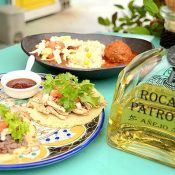
March 7, 2020 Ryukyu Shimpo
Miyakojima – Tacos and beans with a spicy flavor that never gets old, refreshing mojitos, and sweet and sophisticated premium tequila.
These can all be enjoyed at El Comal, a Tex-Mex food stand tucked into Shimozato Street in Hirara, Miyakojima.
The owner, Miyakojima-native Akinori Shimoji, 43, said of his cooking, “It’s a simple flavor, but one that you will not tire of,” noting that there were many repeat customers, both local and tourists.
The stand is run by the owner and Toshiyuki Kawahara, 58, who manages the menu and recipes.
Kawahara had previously managed a Mexican restaurant by the same name in Kanagawa, however when Shimoji, who worked in the restaurant at the time, decided to move back to Miyakojima three years ago, they took the opportunity to open the current food stand-style shop.
Kawahara lived in California and New Mexico 28 years prior, and thought that the local flavors there would also have a market in Japan, and began designing recipes.
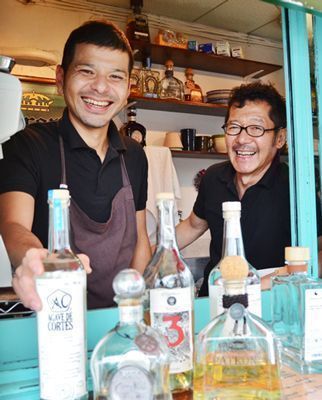
Yoshinori Shimoji (left) and Akinori Kawahara showing off their premium tequila. March 3, Hirara, Miyakojima
“I wanted to create something captured Mexico’s ‘Homemade flavor’ that would be enjoyed in Japan as well.”
Their marquee taco consists of a homemade corn tortilla with chicken or beef and some simple flavoring.
You can also choose to add their special sauce made from a blend of chili peppers.
Also popular is their mojito, made with an abundance of Miyakojima-grown mint, which is exceptional when enjoyed outside in the breeze in the evening and through the night.
You can also enjoy some premium tequila, mescal, and spirits distilled by the stand.
Kawahara commented, “All of the ingredients come from Miyakojima; I wanted to create in Miyakojima the locally-sourced, authentic Mexican food made traditionally by the people indigenous to that region.”
Shimoji added smiling, “I am motivated by seeing customers react to our food with a face that says ‘delicious!’ Since there is no other restaurant like this in Miyakojima, I want the restaurant to continue to be known as unique.”
(English translation by T&CT and Sam Grieb)
Go To Japanses
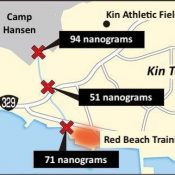
March 12, 2020 Ryukyu Shimpo
It came to light on March 11 that through a water quality study conducted on the rivers and drainage channels in Kin Town, Okinawa Prefecture, high concentrations of organic fluorine compounds (PFOS/PFOA), the use of which is principally prohibited within Japan, were detected in 3 places.
Given that the highest detected values of these compounds were found at a site adjacent to the U.S. Camp Hansen, the Kin Town government claims that it is highly probably that the compounds drained from Camp Hansen.
The drainage channel in which PFOS was detected drain from Camp Hansen to U.S. military Kin Red Beach Training Area.
This water is used for agriculture and in peoples’ daily lives.
Currently there is no legal limit on allowable amounts of the substance in water within Japan, but on April 1 the Ministry of Health, Labour, and Welfare will undertake a policy upholding 50 nanograms (of the total value of PFOS and PFOA) per liter as a provisional target value.
All of the values detected in Kin Town exceed the provisional target value.
Since there were successive discoveries of water quality contamination by PFOS and PFOA in the vicinity of U.S. bases such as Futenma Air Station and Kadena Air Base, Kin Town examined 8 rivers and drainage channels in the town in October 2019.
When doing so, the compounds were detected at levels exceeding 300 nanograms per liter at the mouth of the drainage channel flowing from Hansen to Red Beach.
In November 2019, in an effort to specify the cause of the contamination, additional examinations were conducted at 3 places upstream from the mouth of the drainage channel.
When doing so, levels were detected in the vicinity of Camp Hansen at 94 nanograms per liter, midstream at 51 nanograms, and at the mouth at 71 nanograms.
Town Mayor Hajime Nakama said, “In conjunction with the Okinawa prefectural government, we request an investigation into the source in addition to an examination by specialists on the U.S. military base”.
PFOS is suspected to be carcinogenic, and the use and manufacture of persistent organic pollutants is internationally restricted by the Stockholm Convention (POPs Convention).
The US Environmental Protection Agency (EPA) uses 40 nanograms per liter as the index at which reexamination toward the cleanup of ground water contaminated by organic fluorine compounds such as PFOS is necessary.
(English translation by T&CT and Erin Jones)
Go To Japanese
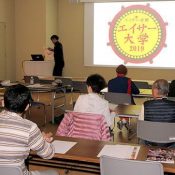
March 9, 2020 Ryukyu Shimpo
The Eisa Museum (Eisa Kaikan) opened two years ago in Koza Music Town, Okinawa City, as a hub to inform on all things eisa—a traditional Okinawan performance.
Its main project, the “Eisa University” lecture series, has been gained popularity.
The “Eisa University” lecture series was held two consecutive years thus far.
The inaugural year offered five lectures over two days and welcomed a total of 101 participants.
For the 2019 series, the offerings were expanded and a total of 15 lectures were held between June 2019 and February 2020.
The lectures covers a great breadth of topics: eisa history from its origins through modernity; eisa variations and regional differences; lunar Bon Festival customs; the allure of the mo-ashibi eisa; the history of the chondara dance; eisa and social changes in postwar Okinawa; creative eisa; eisa as a tourist resource; and eisa as a youth-group activity. Lecturers came from diverse backgrounds, including professors from the Okinawa Prefectural University of Arts and Okinawa International University, as well as researchers from other organizations.
For the 2019 lecture series, the total number of participants exceeded 270; many were from out of town, including the ten participants visiting from other prefectures.
The lecture on finger whistling, which is used to add excitement to eisa, was especially popular.
Authorized tour guides of the Okinawa City Tourism and Products Promotion Association, Zenko Hazama, 69, and Fusae Karimata, 67, (both Okinawa City residents) said they enjoyed learning about the allure of eisa in depth through Eisa University.
As tour guides, they were eager to share what they learned with students visiting from other prefectures on class-trips.
Osamu Maejima, 42, planner and coordinator of the lecture series, moved to Okinawa from the main islands of Japan a year ago when his work brought him to the Universities of the Ryukyus.
He was exposed to eisa when he was young, and became fascinated by the dynamic and powerful group performance.
He has since passed the upper-level eisa certification test, and now lives in Okinawa City.
Maejima is thrilled for next year’s lecture series: “Uchinanchus (Okinawans) are enamored by eisa.
I hope to help spread this wonderful traditional performance.”
Every year, the city of Okinawa hosts the prefecture’s biggest event, Okinawa Zento Eisa Matsuri, which will be held for the 65th time this year.
The city declared itself “City of Eisa” in 2007 and consequently, the Eisa Museum was founded.
This year the Eisa Museum will celebrate its two-year anniversary, from March 22 until the end of the month.
Yoshiaki Kinjo, director of the Eisa Museum said, “As home of the eisa, we will continue to expand our lecture series, and provide the locals with more opportunities to feel proud of the eisa tradition.
We are looking forward to promote our unique museum to the domestic market as a place to experience, enjoy and grow familiar with eisa.”
(English translation by T&CT and Monica Shingaki)
Go To Japanese












 Webcam(Kokusai Street)
Webcam(Kokusai Street)


